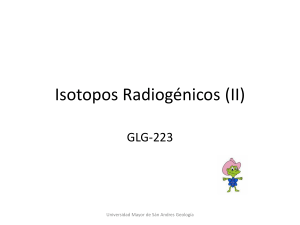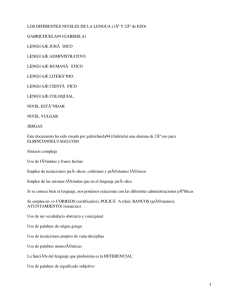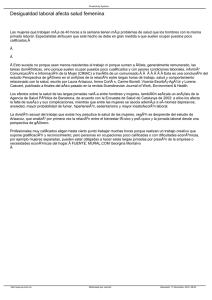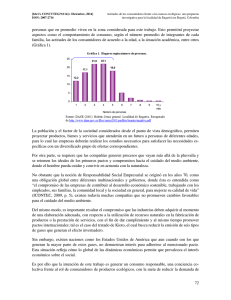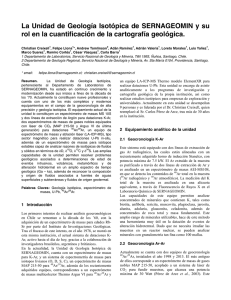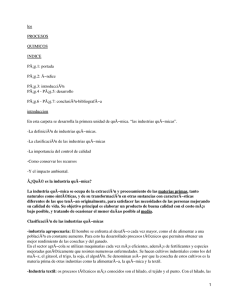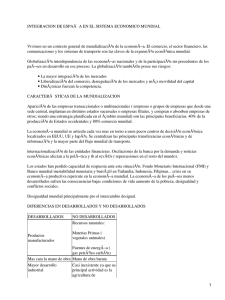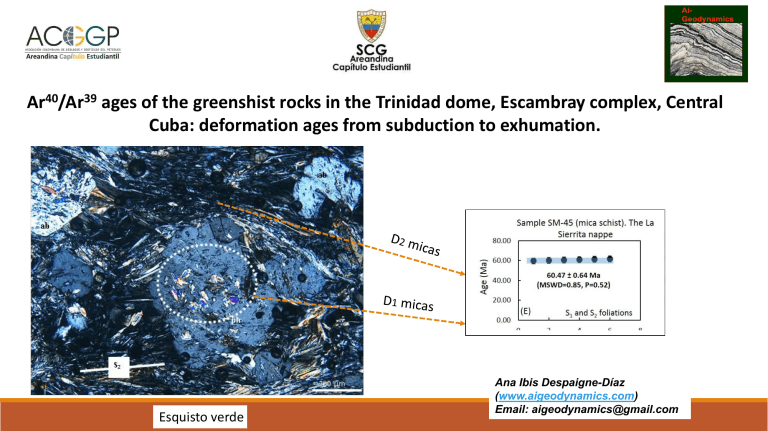
Ar40/Ar39 ages of the greenshist rocks in the Trinidad dome, Escambray complex, Central Cuba: deformation ages from subduction to exhumation. Esquisto verde Ana Ibis Despaigne-Díaz (www.aigeodynamics.com) Email: [email protected] METODOLOGÍA DE TRABAJO PARA DATACIONES DE Ar40/Ar39 EN ROCAS METAMÓRFICAS DE GRANO FINO (esquistos verdes). -Recomendaciones- ESCAMBRAY : El complejo metamórfico más grande del Caribe (1800 km ) 2 CARACTERÍSTICAS País: CUBA Provincias: Villa Clara, Cienfuegos, Sancti Spiritus, Cuba central Pico mas alto: Pico San Juan: 1140 m Coordenadas: 21° 59´ 05´´ N 80° 07´´57´´ W Posición de Cuba en la configuración tectónica del mundo Placa del Caribe Area: ~3.300.000 km 2 Velocidad: 10-11 mm/year Borders: North American Plate, South American plate, Cocos and Nazca plate. Movement: east CUBA Placa de Norte America QueCuriosidades.com Area: 76 million km 2 (segunda mas grande del mundo) Velocidad: 15-25 mm/year Borders: Cocos Plate, Caribbean Plate, Swan-Cayan transform, Motagua-Polochic transform zone, Enriquillo-Planteen garden fault system, Chersky range, Laptev sea rift, Ulakhan fault, Okhost plate, Aleutian trench, Queen Charlotte fault system, Cascadia subduction zone, San Andreas fault, East Pacific rise, Gulf of California, Middle America trench, Juan de la Duca explorer, Gorda Rivera, Nazca plate. . Movement: west (72-100Ma) (56-66 Ma) Pangea: 375 Ma (Paleozoic-early Mesozoic) Break off: Early- Middle Jurassic (175 Ma) (32 Ma) (13 Ma) Variación del estrés con el desplazamiento de la Placa Caribe σ1 σ1 σ1 (Garmont et al., 2017) Figure by K.M. Groom, modified from Malfait and Dinkleman 1972 Lίmites de la Placa Caribe N-S: Transform N: Transform fault Belize-Guatemala (Motagua fault)-Honduras, SwanCayman, Hispaniola, Puerto Rico, Virgen islands, Puerto Rico trench. S: 7.686m (Malfait and Dinkelman, 1972) Transform dextral fault and subduction. Interaction with the SAP forming Barbados Trinidad and Tobago and island off-coast Venezuela and Colombia (Mann, 1999) E-W: Subduction zones E: Subduction zone in the Lesser Antilles. The oceanic South America plate subducts under the Caribbena plate. W: The Cocos plate subducts beneath the Caribbean plate and forms the Central America volcanic arc. The CP is subducting below both the Panama Plate and the North Andean Plate (Malfait and Dinkelman, 1972). Inserción de la placa Caribe en el espacio Interamericano e interacción con las márgenes continentales Late Eocene Pre-late Eocene Cuba forms part of the North American plate (sutured) Oceanic elements and volcanic rocks formed part of the leading edge of the Caribbean plate (www.ugr.es) Image source: http://www.geographynetwork.co m/ and compilation by García-Casco et al., 2006 / www.agcasco.ugr.es/personal. Margenes continentales Norte: Plataforma de Bahamas Sur: Margen de Yucatán (Caribeana) Geología regional de Cuba Elementos oceánicos • Arcos volcánicos K y Paleógeno • Ofiolitas Relacionados a la Placa Caribe Falla Oriente . Geological sketch map of Cuba after Iturralde-Vinent (1996) showing location of the Escambray complex and the Cuban fold and thrust belt CORTE GEOLOGICO DE CUBA CENTRAL ?? Zona de sutura La cúpula de Sancti Spiritus ha sido mas estudiada y dentro de ella las unidades de alta presión (Unidades II y III). Se conocían datos de edades geocronológicas solo de las unidades de alta presión II y III ( ˷85-65 ma) (Millán, 1997) Los trabajos estructurales de detalle comienzan a realizarse en el 2006 (Stanek et al., 2006). La estructura geológica revela movimiento de los napes hacia el NE en la cúpula de Sancti Spiritus. Generalidades de la estructura geológica regional (similar a la unidad III) (similar a la unidad II) Trabajos estructurales de detalle en la cúpula de Trinidad H G (Mapa base Millán y Alvarez-Sanchez, 1992. Modificado con datos de los autores) Generalidades de la estructura geológica regional, cúpula de Trinidad (énfasis en las rocas de esquistos verdes) Movimiento tectónico de los napes al N - NE (Despaigne Díaz et al., 2017) H G Zona de melange de la Loma Santa Lucia desde Caleta de Muñoz hacia el Colorado ELEMENTOS ESTRUCTURALES COMUNES A TODOS LOS NAPPES (LINEACIONES) Lineaciones de intersección L3 (intersección de las foliaciones S2 y S3) L3 L3 Nappe La Sierrita perfil GSR Nappe Yaguanabo perfil YG Lineaciones minerales actinolita Nappe La Sierrita perfil C ELEMENTOS ESTRUCTURALES COMUNES A TODOS LOS NAPPES (PLIEGUES) Plegamiento de S o= Pliegues fase F 1 Plegamiento de S 1= Pliegues fase F 2 Plegamiento de S 2= Pliegues fase F 3 Plegamiento de S 3= Pliegues fase F 4 F1 F2 Nappe La Sierrita perfil GSR F3 Nappe Yaguanabo perfil YG NE Nappe La Sierrita perfil SM F4 Nappe La Sierrita perfil SM Grietas en escalón ELEMENTOS ESTRUCTURALES COMUNES A TODOS LOS NAPPES NNW SSE SSE Deformaciones dúctiles-frágiles (venas en escalón y sigmoidales) σ3 σ1 Nappe La Sierrita Perfil SO Nappe La Sierrita perfil SO SE Ep 215/60° SE Riedel fractures Ep:215/60° Venas trasnpresivas y micropliegues ejes muy abruptos Nappe Monforte perfil YG Nappe Río Chiquito perfil GSR Corte estructural generalizado de la estructura geológica regional con pliegues volcados con sentido de movimiento tectónico al N-NE Perfil C-D Clivaje paralelo a S2 en metasedimentos NE S2 S3 Indicadores cinemáticos en secciones delgadas orientadas E N Q 500µm 500µm D 500µm Pressure fringes en mineral metálico Pressure fringes en mineral metálico Porfiroclasto de albita rotado Mica fish E NE qtz S2 cc N Microfalla sintética al movimiento C D S3 0.6 mm Mica fish en bandas de recristalización dinámica de cuarzo. 500µm C milonita NAPPE YAGUANABO NAPPE LA SIERRITA S2 ph SS2 2 chl Mg Mgchl chl S1 ph grt Grt S1 Fe chl Fe-chl qtz S2 500 µm Foliación S1 relictica dentro de albita 222 µm SM-45 (Mg+Al+K+Fe+Si) Esquisto actinolítico talcoso plegado y milonitizado. ep Ep qtz Qtz (a) 222 m SM-45:Mn (K+Mg+Fe) Granates con bordes de retrogresión de clorita. Foliación S1 y S2 NAPPE RÍO CHIQUITO Biotita orientada en S2 S3 S2 S2 clorita S1 biotita 500 µm S1----mica blanca T S2 y S3. Fuerte reorientación de minerales. ab Estructura regional con las deformaciones detectadas en el campo y secciones delgadas D1-3…dúctil/metamorfismo/subducción-colisión D4-5 Dúctil-frágil (exhumación) Clivaje en serpentinitas foliación en metasedimentos (doming process)) Deformaciones dúctiles ESTIMACIONES DE P-T D1---- 11 kbar a 400° C (i.e 35-25 km), D2---- 8-9 kbar , ≥ 400° y hasta 480 ° D3----5 kbar , 150-300°C D4---- hasta 150°. D1----Pico metamórfico. Incremento de P y T relacionado a subducción. D2----Tramo de calentamiento seguido de enfriamiento y retrogresión relacionado a subducción y colisión. D3-----Retrogresión y enfriamiento progresivo (exhumación) Trayectorias P-T unidad III (Schneider et al., 2004; Stanek et al., 2006) Trayectorias P-T Samaná, Dominican Republic (Escuder-Viruete et al., 2011)) (Despaigne-Diaz et al., 2016) Por que el método de datación Ar40/Ar39 para datar deformaciones???? Presencia de micas crecidas y/o deformadas en varias fases de deformación (D1-3)……Tienen K (phengitas) Presencia de micas viejas conservadas dentro de porfiroblastos de albita y/o dentro de microlitons (D1 micas) Secciones delgadas con una sola deformación permite datar una deformación especίfica. Foliación principal (D2) Diagramas binarios de clasificación de micas para todos los napes moscovita/paragonita [KAl2(AlSi3O10)(OH)2] moscovita 6 calcoesquistos Na = K esquistos cuarzo micáceos metabasitas [NaAl2(AlSi3O10)(OH)2] paragonita metapelitas Al (a.p.f.u) 5 rr Co Two Tschermak-type substitutions, SiMg = AlVI + AlIV and SiFe2+ = AlVI + AlIV, lead to the theoretical Mgceladonite [KAlMg(Si4O10)(OH)2] and Feceladonite [KAlFe(Si4O10)(OH)2] end-members. 4 i ac el ón White mica with a chemical composition along the muscovite– celadonite join is common in metapelites and is referred to as phengite. If phengite is high in sodium, the celadonite substitution is usually less pronounced (Guidottti & Sassi, 1976). l ea lin 3 6 6.4 6.8 Si (a.p.f.u) 7.2 7.6 fengita/celadonita Micas ricas en celadonita con contenidos de silicio desde 6.32 - 7.3 apfu, Fe= 0.2-0.6, Mg=0.25 – 1.1, Mg # = (Mg/(Mg+Fe2+) entre 0.50-0.90. pobres en paragonita con contenidos de Na ≤ 0.4 apfu y se clasifican como FENGITAS. ISÓTOPOS Átomos que tienen el mismo número atómico, pero diferente masa atómica. Es decir, contienen el mismo número de protones pero difieren en el número de neutrones. K40 40 Ca 40 Ar (hyperphysics) PRINCIPIOS DEL METODO Because 39ArK can only be produced by a fast neutron reaction on 39K [ 39K(n,p)39Ar ], all samples dated by the 40Ar/39Ar technique must be irradiated in the core of a nuclear to convert a stable form of potassium (39K) into the radioactive 39Ar. a standard of known age is co-irradiated with unknown samples, it is possible to use a single measurement of argon isotopes to calculate the 40K/40Ar* ratio, and thus to calculate the age of the unknown sample. 40Ar* refers to the radiogenic 40Ar, i.e. the 40Ar produced from radioactive decay of 40K. 40Ar* does not include atmospheric argon adsorbed to the surface or inherited through diffusion and its calculated value is derived from measuring the 36Ar (which is assumed to be of atmospheric origin) and assuming that 40Ar is found in a constant ratio to 36Ar in atmospheric gases. The sample is generally crushed and single crystals of a mineral or fragments of rock handselected for analysis. These are then irradiated to produce 39Ar from 39K. The sample is then degassed in a high-vacuum mass spectrometer via a laser or resistance furnace. Heating causes the crystal structure of the mineral (or minerals) to degrade, and, as the sample melts, trapped gases are released. For the application of the Ar40/Ar39 method to age dating it is essential to define a closure temperature. The closure temperature (blocking) range of a mineral is the temperature range over which a mineral changes from an open system to a closed system for the isotopes of interest. CLOSURE TEMPERATURE Anfibol Biotite Moscovite Feldespato K Any mineral or rock containing K Temperatura de cierre Estudiando este ritmo de descomposición del 40K, y la cantidad de 40Ar contenido en las estructuras cristalinas de la muestra de roca, en un proceso de enfriado suficiente como para que el argón radiogénico no se disperse fuera de los cristales, es posible calcular la data de formación de la roca y una cuantificación en la espectrometría de masas (es.Wikipedia.org). Temperatura de cierre de los minerales 330-450° (Research gate) (Dengfeng Li et al, 2019) Consideraciones Temperatura de cierre de phengitas (350-450° for the 40Ar/39Ar system (Purdy and Jaeger, 1976; Kirschner and others, 1996, McDougall and Harrison, 1999). Since temperature during greenschist-facies metamorphism in the studied units was below the activation temperature for Ar diffusion in phengitic mica we consider that our 40Ar/39Ar ages correspond to the metamorphic growth of phengites (D1) near to peak metamorphic conditions (D2) and further retrogression and/or recrystallization during D3. CÁLCULO DE LA EDAD In a metamorphic rock that has not exceeded its closure temperature the age likely dates the crystallization of the mineral. Dating Rof movement λ on fault systemsJ is also possible with the 40Ar/39Ar method. is the radioactive decay constant of 40K (approximately 5.5 x 10−10 year−1, corresponding to a half-life of approximately 1.25 billion years), is the J-factor (parameter associated with the irradiation process) the J parameter must be determined by irradiating the unknown sample along with a sample of known age for a standard. is the 40Ar*/39Ar ratio. The J factor relates to the fluence of the neutron bombardment during the irradiation process; a denser flow of neutron particles will convert more atoms of 39K to 39Ar than a less dense one. (Stanek et al., 2006 and references therein) (Mabujina Complex) (Yayabo) Dating of the low grade rocks (unit I) metamorphosed in a green schist facies gives age of metamorphic peak and thus a better constrain of the subduction history for these rocks together with the cooling ages reported in the eclogites of unit III. (Stanek et al., 2006) Cluster de eades geocronológicas : 85-65 Ma en rocas de alta presión y corteza oceánica: Subducción-exhumación durante K tardío-Terciario Temperaturas y presiones del metamorfismo en facie de esquistos verdes (Spear, 1993) A major advantage of the argon-argon method is that the sample can be heated incrementally. This process, known as "step heating", provides additional information on the age of the sample (Merrihue and Turner, 1966). Reheating events and diffusion of argon from the boundaries of the grain can result in lower 40Ar/39Ar ages near the boundaries of the grain. A more representative age of initial cooling is given by the "plateau age", where the edge effects give way to a constant 40Ar/39Ar date. Total fusion ages A single grain is analyzed in one heating step (total fusión) with a laser for certain amount of time (in the case of these samples for 1 minute to guarantee a homogeneous temperature), then the gas is measured with a mass espectometer. Total fusion is performed using a laser and results are commonly plotted on probability distribution diagrams. Relaciones texturales de los minerales (micas) en cada muestra para determinar estrategia de trabajo, dificultades. Aspecto general de un afloramiento (Escambray, Cuba central) Una foliación marcada en esquistos verdes metavolcánicos Ab El estudio de la sección bajo el microscopio petrográfico revela la presencia de tres foliaciones. S1 S2 S1: contenida dentro de porfiroblastos de albita (Ab) S2: plegada en la matriz S3 S3: Planar axial a los planos axiales de los pliegues S2. Ab S1 Porfiroblasto de albita con una foliación S1 plegada, relictica, que no tiene continuidad en la matrriz S2. El grano fino de las micas impide hand-picking en la muestra o irradiación con laser in situ. Se mezclan al moler la muestra (D1-3) D1, D2 micas S1 S2 S1 Estrategia de trabajo. Como datar las deformaciones? Superficies detectadas bajo el microscopio D1 micas ph S2 deformaciones D1 (S1) D2 (S2) D3 (S3) D1, D2, D3 micas mezcladas Las muestras con solo la foliación principal S2 permitieron datar esta deformación con precisión (D2) Todas las muestras tenían una foliación S2 muy penetrativa S1 D2 micas Metodología usada para separar las micas en muestras de grano fino (esquistos verdes) Relaciones texturales de las micas y las deformaciones determinadas en cada muestra a usar en la datación (S1, S2 y S3). 1 Moler la muestra (Se mezclan todas la micas de diferentes foliaciones). 2 Tamizado en fracciones de 125, 212 y 350 micras 3 Baño de ultrasonido para separar las micas de otros minerales. Secado en estufa. 4 Separación de micas bajo el microscopio petrográfico (cristales con mínimo tres capas, sin inclusiones). De 60-80 granos por muestra. 5 Listas para ser irradiadas!, irradiación, tiempo de espera para la descomposición del K en Ar. Total fusion age results. CURTIN UNIVERSITY, WESTERN AUSTRALIA Western Australian Argon Isotope Facility Profesor Fred Jordan Department of Applied Geology and JdL Centre Curtin university of Technology GPO Box U1987, [email protected] List of mineral analysable by 40Ar/39Ar Micas – muscovite, biotite, phengite. Feldspars – K-feldspar and plagioclase. Amphiboles. Whole rocks – volcanics, slates, phyllites. Pyroxenes – e.g., found as inclusions in diamonds. Feldspathoids – leucite, nepheline. Clays – illite, celadonite. Sulphates – alunite, jarosite. Evaporites – sylvite, carnallite, polyhalite, langbeinite. Glass – obsidian, tektites, pseudotachylite. Manganese oxides – cryptomelane, hollandite. Tourmaline - Shorl, Dravite, Elbaite The 40Ar/39Ar laboratory Application of 40Ar/39Ar dating technique - Timing of volcanic eruptions and magmatic episodes. - Las muestras Determining thermal histories of metamorphic rocks. Were irradiated for 40 hours in the US Geological Dating igneous rock crystallisation ages and thermal histories. Survey nuclear reactor (Denver, USA). The 40Ar/39Ar analyses were performed at the Dating paleaomagnetic sequences. Western Australian Argon Isotope Facility at Determining ages of terrestrial impact craters. Curtin University. For each sample, a series of single crystals of phengite were analyzed in one Dating meteorite and lunar samples. heating step (total fusion) using a 110 W Spectron Dating of deformation events. Laser System, with a continuous Nd-YAG (IR; 1064 nm) laser rastered over the sample for 1 minute Dating of hydrothermal and alteration events. to ensure an homogenously distributed Dating of sediments. Sedimentary provenance studies. temperature. Dating of authigenic growth events. Dating hominid evolution. Determining ages and thermal events of sandstone feldspar cements. Ar40/Ar39 en micas de los nappes de esquistos verdes de la cúpula de Trinidad, Escambray (total fusion ages) D1………60.47 ± 0.44 Ma (Pico metamórfico Paleoceno medio) D2………56.32 ± 0.4 Ma (colisión-exhumación Paleoceno superior) D3……… 50-60 (micas muy mezcladasexhumación). Como se resuelve?...evidencias geológicas…..Paleoceno tardío-Eoceno temprano (Despaigne-Diaz et al., 2016) Resultados de edades Ar/Ar (total fusion ages) Sample 7CF3A Grains per Weighted mean MSWD total fusion sample ages 7 57.20 ± 1.80 0.28 P 39Ar% Normal Isochron* Inverse Isochron* K/Ca 2s 0.95 100 58.34 ± 3.48 58.52 ± 3.47 0.3 ± 7 100 57.00 ± 1.91 56.30 ± 2.41 0.08±0.33 G-102 10 56.7 ± 1.4 0.29 0.98 G-103 13 56.32 ± 0.40 1.23 0.26 G-104 8 58.1 ± 1.1 0.98 0.44 100 58.30 ± 2.59 58.23 ± 2.25 0.48 ±0.5 SM-45 6 60.47 ± 0.64 0.85 0.52 100 56.30 ± 7.87 55.89 ±8.25 8.± 1723 SM-47 11 59.4 ± 0.8 0.9 0.52 62.5 60.49 ± 2.84 56.73 ± 4.35 1.3 ± 3.4 56.8 ± 1.1 0.4 0.80 62.5 60.49 ± 2.84 56.73 ± 4.35 1.3 ± 3.4 40.19 ± 13.29 39.57 ± 0.02±0.1 12.57 56.64 ± 3.91 56.75 ± 3.85 20 ± 46 92.7 56.83 ± 1.32 55.38 ± 1.58 0.67±0.23 SR-65 7 36.7 ± 7 0.64 0.80 100 SR-65b 9 57.4 ± 3 0.48 0.87 100 Appendix 2A 40Ar/39Ar data of all studied samples. All analyses correspond to phengite * Weighed mean age in (Ma). Sample SM-47 gives two distinct age groups (see text for discussion) (Despaigne Díaz et al., 2017) MSWD (PROBABILITY) 0.28 (95%) The MSWD or Mean Sum Weighted Deviates is a statistical "goodness-of-fit" indicator where the higher the MSWD value, the poorer the line fits the data. Commonly accepted MSWD values are less than 2.5. S2 S1 Resumen de las fases de deformación detectadas en los nappes de esquistos verdes de la cúpula de Trinidad, Escambray Deformaciones D1 (subducción) Pliegues isoclinales D2 (colisión-exhumación) Pliegues asimétricos vergentes y cabalgamientos al NNE. Serpetinitas cizalladas con foliación paralela a la foliación S2 en los metasedimentos. D3 (exhumación progresiva) Edades 60.47 ± 0.6 Ma 40Ar/39Ar of phengite from the GSFU (Despaigne-Díaz et al., 2016) 56.8 ± 1.1 Ma 40Ar/39Ar of phengite from the GSFU (Despaigne-Díaz et al., 2016) 50-56 Ma basado en evidencia geológica Pliegues volcados al NNE y cizallas conjugadas D4-5 (exhumación tardía) Estructuras dúctiles-frágiles, pliegues abiertos, fallas normales y de strike slip ≤45 Ma basado en evidencia geológica GSFU: Greenschist facie units Intervalo de tiempo de las deformaciones de todas las unidades del Escambray Diagrama P-t de las unidades de esquistos verdes del Escambray (unidad tectónica I), cúpula de Trinidad y las unidades II (esquistos azules) y III (eclogitica) de la cúpula de Santi Spiritus. Comparación con el complejo Samaná, Republica Dominicana. Primeros pebbles de HP en cuencas adyacentes (Despaigne-Diaz et al., 2016) Despaigne-Diaz et al., (2017). Somin and Milla´n (1981), Hatten and others (1988, 1989), Somin and others (1992), Stanek and Maresh (2007). Edades de Ar40/Ar39 de las unidades de esquistos verdes del Escambray. Comparación con las unidades II y III de la cúpula de SS, la plataforma de Bahamas y el complejo Samaná, República Dominicana. Schneider and others, (2004). Escuder-Viruete and others (2011a). Iturralde-Vinent others (2008) and (Despaigne-Diaz et al., 2016) Modelo tectónico evolutivo para el Escambray (todas las unidades) Arrest of volcanic activity Active volcanic arc Nape de esquistos verdes NE SW Nape de alta presión Corteza del Proto Caribe (Despaigne Diaz et al., 2017) Contribution to the IGCP Project “Subduction zones of the Caribbean” Referencias usadas en la presentación están contenidas dentro de los artículos.



